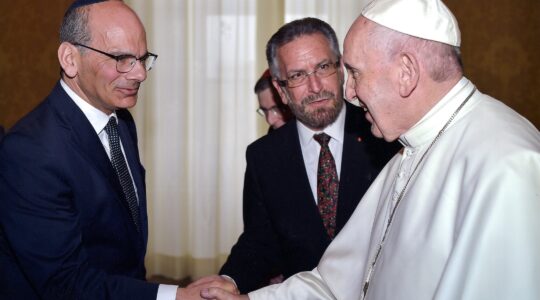It is rather easy, at our Passover seders, to discuss the four questions, the four children, the five rabbis, and even the ten plagues—although it is uncomfortable to rejoice at the suffering of others. But discussing the Maggid section, the official telling of the story of the Exodus, the centerpiece of the Haggadah, is a lot harder. It is composed of many, many biblical verses.
To confront the Maggid challenge, I decided to look at the section as a whole, not just bit by bit as we generally do. Why did the rabbis choose four verses from Deuteronomy (26:5-8) to tell the story at the seder? Perhaps because these verses present the shortest version of the Exodus story. Or maybe because these verses thank God for freeing our ancestors from slavery.
The Maggid midrash, beginning with “A wandering Aramean was my father,” is composed of 21 discrete, short passages. As we read through them, we immediately notice that for 10 of the first 12 midrashim the interpretive technique is to align a verse, generally from Exodus, to each snippet of verse from Deuteronomy. Here is an example: “They imposed heavy labor upon us (v. 6),” as it says: “The Egyptians ruthlessly imposed upon the Israelites various labors” (Exodus 1:13). It is not clear, however, in what way this Exodus verse, and others like it, deepen our understanding of the Deuteronomy verses.
The Maggid midrash is issuing a call to act, to intervene on behalf of innocent and vulnerable people.
About halfway through the Maggid midrashim, there is a shift in literary style. Instead of just aligning verses from Exodus with verses from Deuteronomy, a phrase from Deuteronomy is followed by a statement in the form X is Y and then (usually) a supporting verse. For instance, “And [God saw] our oppression” (v. 7), this is the persecution, as it says “Moreover, I have seen how the Egyptians oppress them” (Exodus 3:9). But you might still say, this midrashic technique is not very different from the previous one. What, then, is the point of citing all these Exodus verses?
Here is an answer. The midrash on another section of that same verse from Deuteronomy says, “God saw our plight (onyenu),”—“this is the cessation of sexual relations [between husband and wife so as not to produce a child].” However, the Deuteronomy phrase “our plight” does not imply that specific meaning. The very next midrash, says “And [God saw] our misery (amalenu),” – “these are the sons, as it says, “Every boy that is born you shall throw into the Nile but let every girl live” (Exodus 1:22). Again, there is little basis for interpreting the Hebrew word amal as child or son. What are we to make of these two midrashim which are not like the others that precede or even follow them?
I am suggesting that the author of the Haggadah’s midrash interpreted these two Hebrew phrases in ways that bore little resemblance to what the words mean—which Midrash does allow—because he had a message he wanted to convey. The brief synopsis in Deuteronomy does not make any reference to the killing of newborn Israelite boys. It was therefore crucial for the author to include this information by citing the Exodus verse. When the Israelite midwives refuse to kill the boys, Pharoah instructs his entire nation to throw them into the Nile (Exodus 1:22). This verse thus lays the basis for wiping out an entire people by killing its male children.
Since only these two midrashim of the 21 depart from interpreting a verse according to the simple meaning of its words, and since these two appear at the precise juncture of the two styles of midrash, it follows that these two midrashim communicate a key point of the Maggid section: to condemn the tragedy that befell children at the hands of adults and Pharoah’s evil desire to obliterate an entire people.
To our great chagrin, today too, not only are there attempts at genocide in various parts of the world, but children of all ethnicities are suffering and dying–by drowning, by starvation, by guns, and by other means. The Maggid midrash is thus issuing a call to act, to intervene on behalf of innocent and vulnerable people. This is a message that we need to hear loud and clear on Passover night when we try to experience the suffering of others.
At your seders this year, suggest to your guests to look for a few minutes at the entire set of Maggid midrashim and then ask them which midrashim are not like the others. Or draw their attention to these two unusual midrashim and ask what they mean. As the haggadah says, Go forth and learn. And then take action.
Judith Hauptman is the E. Billi Ivry Professor of Talmud and Rabbinic Culture (emerita) at the Jewish Theological Seminary. She is also the rabbi and founder of Ohel Ayalah, an outreach project that runs Passover seders open to the public.
The New York Jewish Week brings you the stories behind the headlines, keeping you connected to Jewish life in New York. Help sustain the reporting you trust by donating today.




